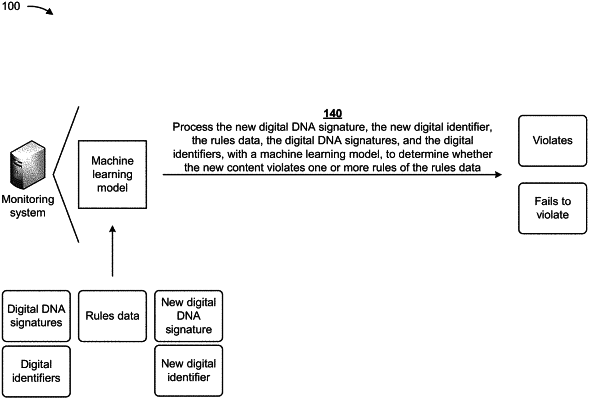| CPC G06Q 50/184 (2013.01) [G06N 20/00 (2019.01)] | 20 Claims |

|
1. A method, comprising:
receiving, by a device, content data identifying content created by users and metadata associated with the content,
wherein the content created by the users includes one or more of:
lines of code, or
an object designed by a user;
receiving, by the device, rules data identifying rules associated with utilization of the content;
utilizing, by the device, the metadata to generate digital DNA signatures for the content in near-real time,
wherein a digital DNA signature of the digital DNA signatures includes:
information that uniquely identifies the content, and
information that enables the device to determine whether a portion of the content is included in other content;
processing, by the device, the content data, the rules data, the digital DNA signatures, and relationships between the digital DNA signatures, with a machine learning model, to determine a set of variables associated with a set of observations of the machine learning model;
storing, by the device and in a repository, the rules data, all of the content of the content data, the digital DNA signatures, the relationships between the digital DNA signatures, and the set of variables;
providing, by the device and to a client device, a template, associated with the digital DNA signature, based on particular content of the content data;
receiving, by the device and from the client device, new content that is generated based on the template and new metadata associated with the new content;
utilizing, by the device, the new metadata to generate a new digital DNA signature for the new content;
processing, by the device, the new digital DNA signature, the rules data, the digital DNA signatures, and the set of variables, with the machine learning model, to determine a predicted value, of a target variable associated with the set of variables, indicating whether the new content violates one or more rules of the rules data,
wherein processing the digital DNA signatures, and the set of variables with the machine learning model, comprises:
determining, based on using the machine learning model, whether the new digital DNA signature includes the digital DNA signature, and
determining, based on using the machine learning model, information identifying a relationship between the new content and the template; and
performing, by the device, one or more actions based on whether the new content violates the one or more rules of the rules data.
|